#dine navajo
Explore tagged Tumblr posts
Text
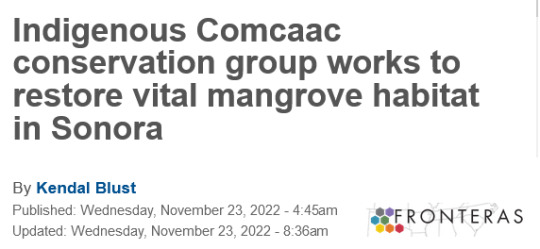

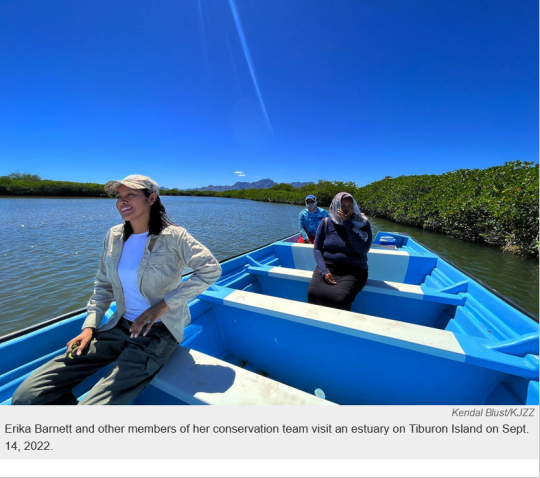
Eliseo Barnett begins the short trip from the little town of Punta Cheuca to the vast Isla de Tiburon -- the largest island in the Gulf of California and part of the Indigenous Comcaac territory. [...] Erika Barnett [...] watches dozens of herons, seagulls and small coastal birds bask in the shallow waters [...]. Beyond them stretches a dense mass of green leaves -- part of a huge mangrove estuary on Tiburon Island. It’s one of about a dozen interconnected stands in the Infiernillo Channel. A narrow stretch of ocean between the island and the Sonoran coast, entirely within Comcaac territory, the channel is known for its biodiversity and abundant seagrass meadows and is a protected wetland area.
Mangroves cover some 960 hectares — or nearly 2,400 acres — of the channel.
“It’s like a kindergarten,” Barnett said.
A local conservation leader, she compared the mangrove forest to a nursery, providing a protected habitat for important marine species like crabs, shrimp and fish, as well as birds and sea turtles. [...]
It all starts with collecting mangrove propagules — the long, slender green and brown stalks that grow from mangrove flowers — from the estuaries and beaches in the Infiernillo Channel. Walking along the beach on Tiburon Island, Erkia Barnett occasionally stoops down to pick up a stray mangrove propagule. She collects the ones that wash ashore. [...] “It occurred to us to pick them up and keep them” until they sprouted roots, she said. After propagating the plants, her family took them to the El Paraiso estuary nearby.
The conservation team’s current project is much the same — collecting, propagating and reforesting the plants — but on a larger scale. This year, they collected more than 6,000 plants from the channel. [...]

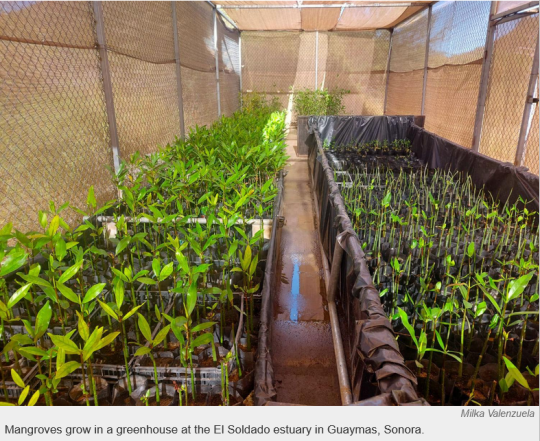
“Climate change is one of the biggest factors impacting the mangrove forests,” Barnett said. Increased heat, drought and rising sea levels are all taking a toll on the plants.
“It is the extreme of extremes, my goodness,” said ecologist Laura Smith Monti, with the Arizona-based Borderlands Restoration Network and The University of Arizona. “The mangroves stands in the Infiernillo Channel are the northernmost mangroves that occur on the West coast for sure.” [...]
And so far, the stands in the Infiernillo Channel are relatively healthy, likely because the protection afforded by the Comcaac community, Monti said. [...] The Comcaac have relied on these mangroves for thousands of years — using them as a source of food, medicine and building materials. [...] This year, after the plants grow large enough in the water-filled Coke bottles, they will be transplanted into soil for another six months or so — a new technique Barnett learned from one of the few other mangrove conservation teams in the region. [...] “It’s something relatively new,” said Milka Valenzuela, who has been running the mangrove reforestation project at the El Soldado estuary near the beach town of San Carlos since 2017. [...]
“I want to continue so that my children and my nieces and nephew might want to follow my example and continue taking care of the mangrove and the environment here in our territory,” [Barnett] said. “Because this ecosystem is important now just for our people, but for the world.”
---
Headline, images, captions, and text as published by: Kendal Blust. “Indigenous Comcaac conservation group works to restore vital mangrove habitat in Sonora.” Fronteras. 23 November 2022. [Bold emphasis and some paragraph contractions added by me.]
#geographic imaginaries#seri and comcaac#dine navajo#tidalectics#mangroves and sonoran desert#ecologies#multispecies
166 notes
·
View notes
Text
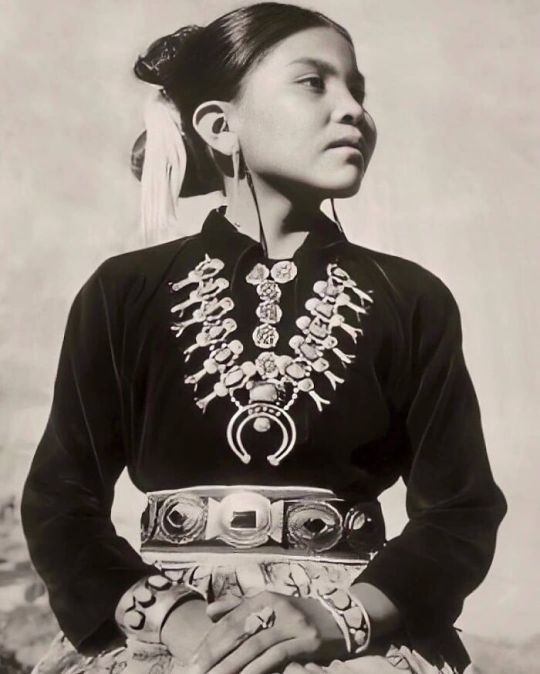
Diné (Navajo) Girl Wearing Silver And Turquoise Squash Blossom Jewelry, 1950
4K notes
·
View notes
Text

Navajo mother and child, New Mexico
Photographer: T. Harmon Parkhurst Date: 1925 - 1945? Negative Number: 003179
468 notes
·
View notes
Text

#beyond the adobe#navajo silver#navajo turquoise#turquoise trail#dinetah#dine#western style#cowboy life#ranch life#boho western#western living#santa fe style
181 notes
·
View notes
Text

1. Is she a main character? YES.
2. Does this character fall in love with a white man? NO.
3. Does this character end up raped or killed at any point during the story? NO / NO.

Heather Hobbs from REZ BALL passes The Ali Nahdee Test
#heather hobbs#rez ball#jessica matten#aila test#ali nahdee test#passes#native women#film#netflix#navajo#dine
97 notes
·
View notes
Text
10 Facts on "What's so special about The Haudenosuanee and Lacrosse?" (From a Native American perspective)
Lacrosse is one of the fastest growing sports in the world right now, but most people look at the sport as expensive, exclusive, and very white. Most people who play the game have no idea the origin that goes behind it or how it was originally played. Lacrosse is a spiritual game for many Native Americans and other indigenous people. Here are 10 essential facts on Lacrosse and the Haudenosuanee. Please leave feedback on your thoughts and opinions of the 10 facts listed below!
Lacrosse is the oldest team sport on our continent, originated by a North American tribe. Some people might say it started around the 1100’s A.D. The Native American tribe originators of this game are the Haudenosaunee.
The Huadenosuanee call lacrosse “Dehontsigwaehs" which means they bump hips.
In the 1630’s, French Jesuit missionaries who were working in the St. Lawrence Valley saw the Huron Indians playing the Medicine Game. The name of Lacrosse is just a reflection of this term, another way of how the French pronounced this game was “le jeu de la cross” (the game of the stick).
Traditional lacrosse game sticks were made from hickory tree wood which represented all plant life. It was said the original game of lacrosse could last several days and have been played with 100 to 1,000 men in a 2 mile radius of land. This game is still played to this day amongst certain Native American tribes.
The cosmology of this game of lacrosse started out way before it was even put on earth for the people; it started out with the animals in the sky world.
The game was given to them by the creator and is very sacred to the Huadenosaunee people, some say it even has healing powers. It's referred to as the medicine game amongst the Haudenosaunee.
This game was called to make peace amongst nations, heal the sick, an exchange to the creator if there was ever a drought, fight diseases, stop war, fix conflict, and to be played with a good mindset at all times, for the creator.
It was never about the outcome of the score but about harmony through the game.
A Haudenosaunee tradition that is still practiced today, is when a male baby is born they receive their first wooden stick and at the end of their journey here on earth, they are buried with the stick. So they can continue playing the game with their ancestors.
Lacrosse is one of the fastest growing sports in the world right now. Thanks to the Haudenosuanee for sharing it with the world!
Let's use this post to spread knowledge to others about the Creators game of Lacrosse. Giving true credit to the Haudenosuanee who gifted this beautiful game to the world. In the spirit of connective blogging, your experiences, insight, stories, and knowledge will help grow this community. Let's create a safe space where we can learn from each other and have allies supporting the Haudenosunee Lacrosse Team's journey as they embark in 2028 Los Angeles Olympics. Here is my question to get the blog started. Do you think after reading these facts, they should be allowed to compete as the first Native American tribe under their own flag? and as the founders of the game of Lacrosse? Yes or No? Have a great day! AHO!
#lacrosee#haudenosuanee#spirit game#wooden stick#olympics#native american#sports#creator game#mohawk#oneida#onondaga#land back#turtle island#cayuga#seneca#tribes#indigenous peoples#indigenous#tuscarora#navajo#dine#iroquois confederacy#six nations#originators
20 notes
·
View notes
Text
Navajo Tech is the first tribal university to offer a PhD program!
(This is especially exciting to me because I was the editor for the Navajo Rosetta Stone software and worked with the tribe for years!)
246 notes
·
View notes
Text

A quick lil' drawings of Roy as a preteen. Yes, he had long hair as a wee lad and, yes, Raymond put it in a tsiiyéél.
17 notes
·
View notes
Text

This week in Taos. The mountain, meadow and sky. :: [Geraint Smith]
* * * *
Walk in Beauty Always
Part of the attitude of the Navajo culture is the concept of Hozro, which is to Live in Beauty, Walk in Beauty Always.
Walking in Beauty: Closing Prayer from the Navajo Way Blessing
In beauty I walk With beauty before me I walk With beauty behind me I walk With beauty above me I walk With beauty around me I walk It has become beauty again
Hózhóogo naasháa dooShitsijí’ hózhóogo naasháa dooShikéédéé hózhóogo naasháa dooShideigi hózhóogo naasháa dooT’áá altso shinaagóó hózhóogo naasháa dooHózhó náhásdlíí’Hózhó náhásdlíí’Hózhó náhásdlíí’Hózhó náhásdlíí’
Today I will walk out, today everything negative will leave me I will be as I was before, I will have a cool breeze over my body. I will have a light body, I will be happy forever, nothing will hinder me. I walk with beauty before me. I walk with beauty behind me. I walk with beauty below me. I walk with beauty above me. I walk with beauty around me. My words will be beautiful. In beauty all day long may I walk. Through the returning seasons, may I walk. On the trail marked with pollen may I walk. With dew about my feet, may I walk. With beauty before me may I walk. With beauty behind me may I walk. With beauty below me may I walk. With beauty above me may I walk. With beauty all around me may I walk. In old age wandering on a trail of beauty, lively, may I walk. In old age wandering on a trail of beauty, living again, may I walk. My words will be beautiful…
Click to hear the prayer spoken in Navajo by Wanye Wilson, a Navajo member.
Linguistic Note: The word “Hozho” in Dine’ (roughly translated) Concept of Balance and Beauty. Consideration of the nature of the universe, the world, and man, and the nature of time and space, creation, growth, motion, order, control, and the life cycle includes all these other Navajo concepts expressed in terms quite impossible to translate into English. Some Navajos might prefer the term: “Nizhoni” meaning ‘just beauty.”
35 notes
·
View notes
Text


This is a colourization I did of a Diné/Navajo woman in regalia. I don't have much info on the original b+w photo.
#history#colorized#colorization#navajo#native american#dine#diné#native#indigenous#indigenous people#indigenous american#arizona#utah#new mexico
4 notes
·
View notes
Text
In the March 1923 issue of National Geographic, a sketch of a tired-looking businessman invites the reader to the Tucson Sunshine-Climate Club. In the accompanying text, Benj. Lowe -- the archetype of the tired, busy, urban, white businessman -- attempts to coax all the other Benj. Lowes out there on the East Coast to recover from their unhealthy lifestyles by spending some time in Tucson, Arizona:
That night, for the first time in his hard-working, rushing life, Lowe came to himself. No vacations for ten years. Heavy responsibilities. Making money? Yes. Now on the verge of breakdown. What was it all worth, anyway? And then his eyes fell on a booklet his worried wife had sent for. It was “Man-Building in the Sunshine-Climate.” …Perhaps you, like Lowe, may find in “Man-Building in the Sunshine-Climate” the clue to robust health.
This form of health tourism began to appear in journal and newspaper advertisements not long after Tucson was originally incorporated as a city, in 1877. A promotional item published in the Arizona Daily Star in 1890 even went so far as to designate Tucson a place to cure serious pulmonary diseases. The rhetoric in these advertisements often framed the Sonoran Desert as “empty,” a place to be “discovered,” as if the Western lands of the continent had remained unoccupied and untouched all along. The process of “Man-Building” advertised by the Sunshine-Climate Club, therefore, carries a double meaning: building oneself and building one’s environment. [...]
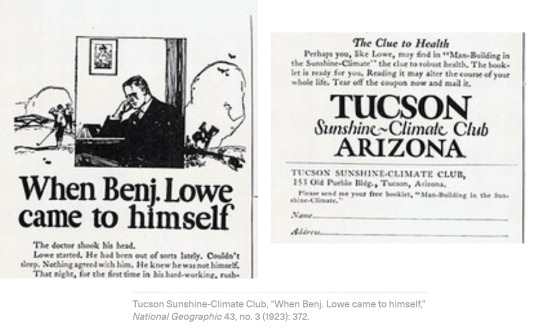
With the proliferation of advertisements in magazines such as Ladies Home Journal and Journal of American Medical Association, a large number of [...] tourists [...] arrived to discover what the desert could offer. [...]
Throughout the late-nineteenth and early twentieth century, hospitals, sanatoria, health resorts, and other structures dedicated to medical treatment multiplied throughout the city of Tuscon [...]. These buildings were not in isolation, in the manner of nineteenth-century sanatoria in Europe or New England. Instead, they were open and integrated into the urban fabric [...]. In the late nineteenth century, upstate New York was among the most popular destinations for pulmonary health pilgrimages. With the opening of the Southern Pacific Railroad in 1880, however, towns with dry climates -- whose “pure and dry air … was not subject to severe seasonal changes” -- started bringing in crowds. [...]
Tucson reached its peak as the “health capital” during the 1930s, when the city’s roughly 30,000 residents were joined by about 10,000 health tourists visiting its twenty-one sanatoria, four hospitals, and four luxury hotels during the peak season. [...]
By 1928, Tucson’s planning and zoning commission had developed a new zoning system for such developments. Spatial buffers were instituted for sanatoria to ensure proper ventilation and isolation, dramatically altering the density and porosity of the city. In a residential neighborhood, for example, sanatoria had to be “set back 200 feet from the property line” and could only occupy “20 percent of the lot.” [...]
---
Sanatoria quickly became a refuge only the rich could afford [...].
Tucson’s Desert Sanatorium was a massive complex of eleven buildings built in 1926 spread out over 160 acres. [...] Telescopic devices called radiometers were housed on the roof of the main hospital building, channeling and directing sunlight through small lenses into the treatment rooms and sunbaths below. The sanatorium’s research center, hospital, and nurse’s residences were scattered across the site [...]. Each patient’s room was annexed to a small wooden balcony visible on the façade. Wet spaces were tiled and interiors white-washed, with baseboards curving away from the walls to prevent dust from settling on their surfaces. Window openings or balconies were carved out from the massive, Pueblo-style exterior walls. The Pueblo style also appears in the interior common spaces as Navajo carpets, mural reproductions, and quilts. Patient’s rooms were named after native tribes such as Pima, Papago, and Navajo. [...] The appropriation of indigenous culture and symbols persisted in the visual language of the Desert Sanatorium. One patient handbook came with a postcard featuring an image of a highly cultivated Navajo garden, and a description of the Sanatorium’s services and facilities adorned with sketches of a “teepee,” “rain cloud,” “thunderbird tracks,” “broken arrow,” “mountain range,” and “bear track.” The symbol of eagle feathers is placed alongside the welcome note by the director to denote his status as “chief” of the complex. The last page of the handbook even contains a personal message from the illustrator, in which he wishes that “each little figure brings happiness … and a very quick recovery. May the Great Spirit Bless and Protect you.”
Despite the generous application of native iconography and mythology in the sanatorium’s literature, few measures were taken to actually care for the infected people in local indigenous communities. By the early twentieth century, indigenous communities, along with other poor minority groups in Arizona had the highest rate of tuberculosis in the region. [...] Carlisle Indian School dedicated an issue of [...] [their] magazine to provide news and guidelines to counter the disease. [...] These analyses are accompanied by photographs of the architectural conditions of the buildings. [...] The issue further suggests the American Indians whose lifestyle shifted from the “more sanitary teepee to the one and two-room box house” could not keep up with hygiene. The magazine sought to enable the “medicine man” to cure the sick [...] but not, however, without yielding to an institutional form of governmentality. The narratives [...] yielded to the top-down institutional logic of controlling bodies by prescribing protocols. [...]
---
The disease, then, is not only a medical construct, but is firstly an environmental construct shaped by the climatic imaginaries which, in turn, shapes the urban context. Secondly, it is a social construct that privileges a certain lifestyle and class through its contagion and access to treatment. Lastly, it is a political construct, as it perpetuates the asymmetrical relationship between communities in the eye of the government and institutions. Amid these racial and economic imbrications, architecture is instrumentalized to facilitate institutional agendas. [...] Architecture perpetuates violence against the figure of the other.
---
Text by: Gizem Sivri. “Desert Fever: Harvesting the Sun, Colonizing the Land.” e-flux (Sick Architecture series). December 2020. [Screenshots were edited by me and display only part of the advertisement, which is shown in its entirety in Sivri’s article. Caption is as it appears in Sivri’s article. Bold emphasis and some paragraph breaks/contractions added by me.]
#agents of empire#tidalectics#indigenous#dine navajo#geographic imaginaries#debt and debt colonies#medical pathologization and modernity#ecologies#multispecies#sick architecture
18 notes
·
View notes
Text



Navajo textiles
collection: Vatican Museums
2 notes
·
View notes
Text
#music#spotify#rock band#rock bands#native artists#indigenous artists#dying language#Graves of the Monuments#GoM#native representation#indigenous representation#support bipoc#support native artists#support indigenous artists#navajo#dine#diné
3 notes
·
View notes
Text

#beyond the adobe#western living#western style#southwestern#cowboy life#ranch life#boho western#dinetah#dine#navajo nation
84 notes
·
View notes
Text




The rez
#photography#photographers on tumblr#aesthetic#cinematicphotography#arizona#adventure photography#lumixs5#lumixphotography#panasonic lumix#panasonic lumixS5#Film look#lightroom#desert aesthetic#rez#navajo nation#hogan#dine
2 notes
·
View notes
Text
"Today, the Navajo Nation has no guaranteed right to use the water that flows in and around their reservation. But this year, that may change — and the future of the tribe will be decided. A long-awaited settlement may be reached between the tribe, their neighboring states and the U.S. government — one that could secure an allocation of the much-contested Colorado River. This series will place the fight for water equity in its historical context, tracing back as far as the creation of the Navajo reservation in the 1800s. It will follow the journey of a Navajo journalist as she strives to understand how this historical fight ties into her family’s personal history."
46 notes
·
View notes